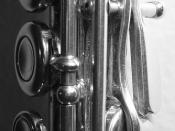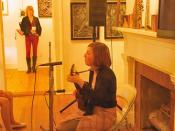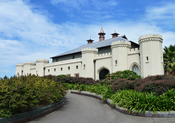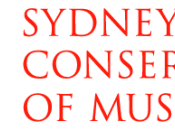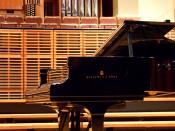Carl Vine, one of AustraliaÃÂs most proclaimed composers, was born in Perth on 8th October 1954. He moved to Sydney in 1975 and joined the Sydney Dance Company as a rehearsal pianist. During this time he composed for a string quartet, orchestra and electronics. He also worked with Graeme Murphy the then artistic director of the Sydney Dance Company. He composed over 20 scores for dance, he has also composed six symphonies, six concertos, music for film, television and theatre, electronic music and numerous chamber works. He is primarily a composer of ÃÂclassicalÃÂ dance and modern ÃÂartÃÂ music. He composed AustraliaÃÂs first full-length ballet, with Graeme Murphy. Also, he composed music for the closing ceremony of the Atlanta 1996 Olympic Games, as well as arranging the Australian National Anthem. He has worked with Gidon Kremer, Kremerata Baltica, Katia Skanavi, Tokyo String Quartet, and the Elias String Quartet, all for Musica VivaÃÂs National Concert Series.
He is the Artistic Director of Musica Viva and the Huntington Estate Music Festival, AustraliaÃÂs most prestigious and successful chamber music festival.
In 1980, he was a lecturer in Electronic Music Composition at Queensland Conservatorium and the co-director and pianist of the performing ensemble ÃÂFledermanÃÂ. In 1984 he was the Musical director of the Australia/New Zealand Choreographic School and later on a resident composer of the Sydney Conservatorium of Music.
In 2005, he was awarded with the 2005 Don Banks Music Award, which recognises artists who have made an outstanding and sustained contribution to Australian Music. Some of his most famous works are the Cello Concerto, premiered by Steven Isserlis and the Sydney Symphony, which won Best Performance of an Australian Composition, Mythological (2000) and Piano Sonata (1990). He is said to be the largest chamber music entrepreneur in the world. `The melodies in Semplice by Carl Vine are quite simple yet effective. They are a simple upwards stepwise motion. The notes are close together in the right hand accompanied by a more stretched out contrary motion style left hand melody, after this, the next bar becomes are more responsive style melody in both hands, nearly always in synchronisation with each other. They melody is not varied throughout, but has slight changes in pitch.
The harmonies are well developed in the piece. The piece is in the key of G major, so it is based around this key and is well connected and developed to create a pleasing and soothing sound for the listener.
The main types of note lengths used throughout the piece are quavers. This is quite and effective tactic, it enables the piece to retain its flow and relaxing style. Crotchets are sued to create diversity and to end phrases. The time signature changes in the piece are another aspect to consider when playing, even though the piece is not varied in melody, the time signature changes add to the piece and allow variety in a simple and flowing piece.
The timbre of the piece is expressed well, mainly through expressive playing using techniques. These techniques include the slurs indicated by the composer, correct use of the pedal and rounding and softening of the notes and end of phrases. The melodic phrases tend to embrace two bars, therefore, the performer thinks in two bar phrases.
Although the composer has indicated only two dynamic markings, the performer may wish and feel the need to vary the sound level as it comes naturally. At the beginning of the piece, mp, mezzo piano indicates a moderately soft start to the piece. It may be desirable to slow down at the end of bar 8 at the poco rall. to create and ending feel. The initial volume may be used again in bar 9 at the a tempo and the decrescendo, crescendo situation can be repeated in bars 15-17. In bar 25, an exaggerated form at the decrescendo is indicated with the pp, pianissimo, to create the essence of a quiet, slow and subtle ending. The decrease in speed is indicated at bar 23, with meno mosso, meaning less movement. The quiet slow, subtle ending is indicated with the morendo al fine at bar 24, meaning gradually dying away.
This piece has little markings of expressive techniques, but the intended subtle feel of the piece is finished off with the constant identical use of pedal to assist in rounding and smoothing the notes and phrases.
The piece is in ternary form. The A section starts at bar 1 and finished at bar 8, where at bar 9 the B section starts. The B section then finished at bar 16 where at bar 17, the A section picks up again and an extended ending is added.
This piece is polyphonic in texture, consisting of two melodic voices. It could be argued that this piece is monophonic as the right hand and left hand are extremely similar, but as there are two parts involved, the piece is polyphonic.
Because of this similarity between the right hand and left hand, the pieceÃÂs texture could be said to be thin, and no so thick or busy.
BibliographyÃÂwww.carlvine.com.
ÃÂwww.amcoz.com.au.
ÃÂwww.chesternovello.com.
ÃÂwww.astramusic.org.au.
ÃÂwww.musicaviva.com.au.
ÃÂAMEB Series 14 Piano Fourth Grade.
